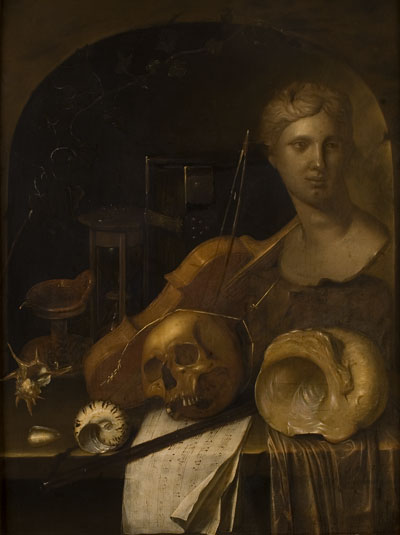Classical Antiquity as a Source of Inspiration
The following paintings and print from the collections at the Royal Museum of Fine Arts Antwerp and the Groeninge Museum in Bruges illustrate the importance of Classical Antiquity as a source of inspiration for portrait sculpture and plastic arts in general in the New Times.



In the New Times, classical portraits – originals, copies and casts - were very much sought after. They were the artistic ideal and the ultimate source of inspiration for artists under training. In allegorical representations, the classical busts also illustrated passing beauty, and they represented the hunger for knowledge about classical sculpture and classical art in general.
The Painter's Studio (1666)
In his book Den grondt der edel vry schilder-const (1604), Karel van Mander describes the art of drawing as ‘the father of painting’ and the basis for any young artist’s training. Jacob I of Oost seems to illustrate this statement in this representation of a painter’s studio. It looks as if Van Oost wanted to promote the use of classical sculptures as study material. A little boy proudly shows his drawing, based on a plaster cast of a female head that has been placed on the table in front of him. All over the studio, we can see all kinds of educational materials.

Groeninge Museum Brugge , inv. 0000.GR00188.II
Humanism
Portrait of Jan Gaspar Gevartius (ca. 1628-1631)
Peter Paul Rubens painted the Antwerp town clerk, Jan Gaspar Gevartius, at work in his study. On the table, we see a marble bust of Marcus Aurelius (121 – 180), the Roman emperor and philosopher, who Gevartius dedicated an unpublished work to.

The humanist Gevartius was a close friend of Rubens. In his position of town clerk (1621-1662), he was in charge of the ceremonies and the city decoration for the Splendid Entry of the Governor Cardinal Infant Ferdinand of Spain into Antwerp in 1635. Along with Rubens, he designed a complex allegorical programme. Their friendship is also shown by the fact that the painter entrusted Gevartius with the education of his oldest son Albert when he was on diplomatic missions. After Rubens’ death, Gevartius was asked to write the text for his tombstone. He was also in charge of the Pompa Introitus Ferdinandi, a book for the Splendid Entry of 1635, with engravings by Theodoor van Tulden, based on Rubens’ designs.
Most historians agree that this painting must have been made around 1628, when Gevartius was working on his study of Marcus Aurelius. Rubens painted the portrait with artists from his studio. The head was probably entirely painted by Rubens himself, but the hands, the book and the garment were painted by one of his collaborators and retouched by the master afterwards.
Vanitas (17th century)
Just like the book, the music score, the violin, the flute and the shells, the bust in this Vanitas still life painting expresses the beauty and richness of life on earth. The bust symbolises the art of sculpturing. Vanitas stills like this one were meant as a warning. The skull, the glowing oil lamp and the sandglass are symbols of death and the transience of earthly pleasures. For those who live in moderation, there is still hope: the corn and the ivy represent resurrection after death. It has not been possible to identify this bust so far, but it is probably based on the often copied, above-mentioned Venus de’ Medici. We do not know if the little known painter Jan Denens copied this Venus during a trip to Italy around 1650, or if he used a print or a plaster copy.

Neoclassicism
Studies of a Bust and Figure Studies (ca. 1786-1829)
Near the end of the 18th century, the study of Antique sculptures was a very popular practice at art academies. In the Neo-Classical era these sculptures were considered as examples of perfect beauty.

Near the end of the 18th century, the study of Antique sculptures was a very popular practice at art academies. In the Neo-Classical era these sculptures were considered as examples of perfect beauty.
This sheet shows how the Bruges painter Joseph Ducq studies a bust from three different perspectives. The sculpture that the artist uses as his example has not been identified so far. It features striking similarities with several marble portrait busts from the first century B.C., like the Portrait Bust of a Man at the Metropolitan Museum in New York (Rogers Fund 1912 [12.233]) and the Bust of Marcus Tullius Cicero at the Museo Nazionale in Rome. This makes us think that the bust, shown here, probably dates back from the same period. The deep-set eyes, the pronounced shape of the nose and the relatively big ears are very similar to the depiction of the Roman orator Cicero, although these similarities are insufficient to identify the portrayed man as Cicero.
